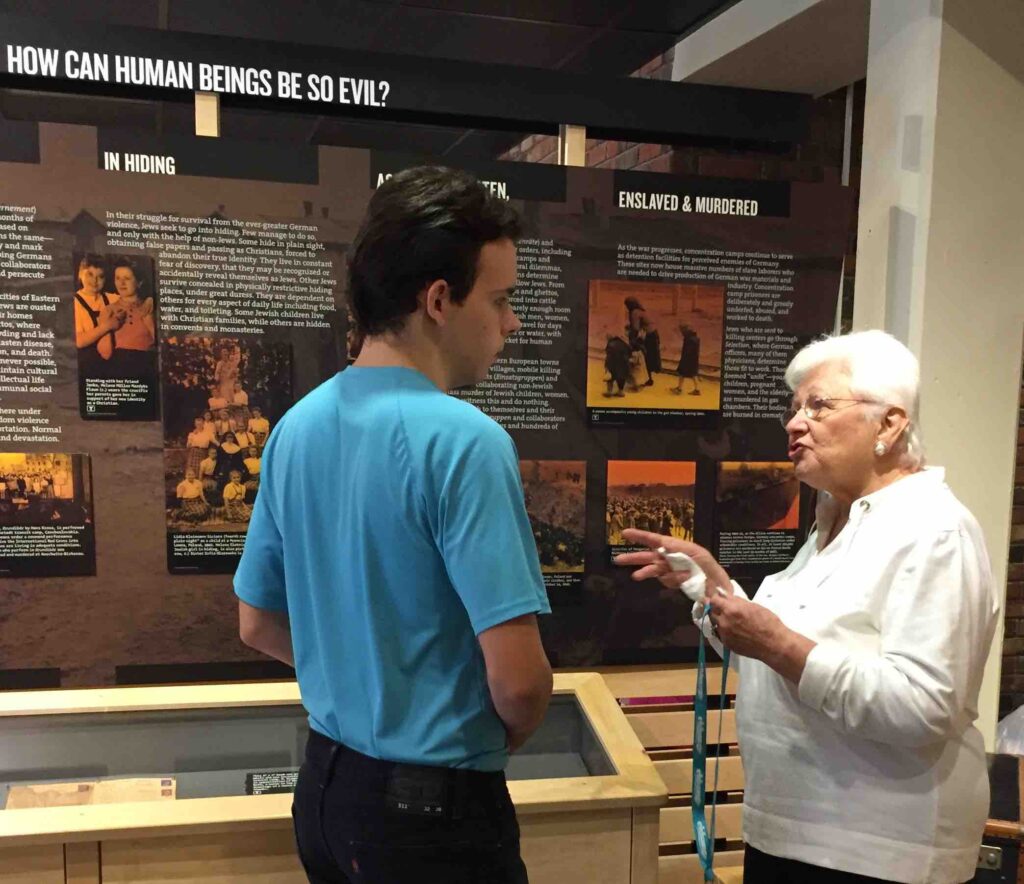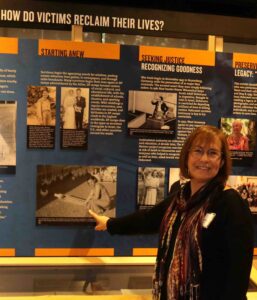
Chhange exhibit becomes more relevant every year
Marissa Crimoli, who teaches the “standing up to intolerance” course required for the entire 8th grade at Holmdel’s Satz Middle School, says, “The highlight of the class, from the students’ perspective, is their visit to the exhibit at Chhange,” the Center for Holocaust, Human Rights and Genocide Education on the Lincroft campus of Brookdale Community College.
Chhange’s exhibit, “Journeys Beyond Genocide: The Human Experience,” focuses on people who eventually settled in areas surrounding the Brookdale campus, but whose early lives, or those of their parents or grandparents, brought them face to face with the worst of humanity during the Armenian genocide, the Holocaust, or the 1994 genocide against the Tutsi in Rwanda.
Founded in 1979, Chhange is one of the first Holocaust education centers in New Jersey and still is the only one in Middlesex and Monmouth Counties. Begun as a lunch-and-learn series organized by Brookdale professors Jack Needle and Seymour Sigler, EdD, with support from Norma Kline, dean of Brookdale’s Community Development, it now provides 50-75 programs each year to over 50,000 students, educators and community members from within Monmouth County, throughout New Jersey and (thanks to the internet) beyond.
Crimoli originally connected with Chhange when she learned it could arrange for Holocaust survivors to speak to her students. “The survivors, while sharing their own experiences, were able to connect to the students and made history real in a way no fictional account could,” she said.

Now, she said, they come to the exhibit for a tour led by a volunteer docent who may be a survivor, or the descendant of one. The exhibit uses language, family photographs and archival items to delineate what life was like before, during, and after the genocides, as well as what changed, what sparked the genocide. “The docents weave their own history into the exhibit, literally bringing history to life.”
Visitors meet the individuals, go through the exhibit and then participate in an educational activity that ties it all together. “The whole experience at Chhange is engaging, interactive and innovative,” she added.
It’s also timely, given the 36% increase in antisemitic incidents throughout the United States reported in the Anti-Defamation League’s annual Audit of Antisemitic Incidents for 2022, the highest ever recorded. The most recent Hate Crime Report from the FBI, from 2021, indicates a 12% increase over the prior year. That, too, is the highest number ever recorded.
Adrienne Aldermeshian, a volunteer docent, is the daughter and granddaughter of Holocaust survivors. Her husband is the son of survivors of the Armenian genocide. She said she became a docent because, “My children are third-generation survivors on both sides from two different genocides. Being a docent gave me the opportunity to learn more so I could answer their questions.”
Among what she learned is the purported connection between the Armenian genocide, which began in 1915, and the Holocaust, which began in 1933.
“We read that when Adolf Hitler met with his commanding generals in 1939, he allegedly said that history would ignore what they were about to do because people had already forgotten what the Ottoman empire did to the Armenians,” she said.

tending to chickens on their farm in Farmingdale.
Aldermeshian thinks that interest in the tours has increased because of the rise in bullying in area schools as well as the rise in antisemitism. So does Chhange Board President Howard Dorman, whose parents were Holocaust survivors.
“When the bullying of a 14-year-old girl in a neighboring community leads to her suicide, then there can be no question of the importance of teaching what hate can lead to, which is what this exhibit really is about—that and the remarkable resilience of survivors,” Dorman said.
“The underlying message throughout the exhibit and everything Chhange does is that all of us have a role in stopping hate. We can and should actively stand up for others instead of being passive bystanders.”
Exhibit co-creator and Chhange’s first executive director Dale Daniels explained that while she and exhibit co-creator Susan Yellin were planning the exhibit, they knew, based on long-standing relationships with the local Armenian community and Holocaust survivors, that they would focus on the Armenian genocide and the Holocaust.
“But at the same time, we had followed the news reports from Rwanda in 1994,” Daniels said. “After meeting Eugenie Mukeshimana, who survived the genocide and has family in Fair Haven, we felt it was important to include a section focusing on the 1994 genocide of the Tutsi in Rwanda. As a result, the exhibit covers three genocides on three different continents in three different eras.”
Although the exhibit first opened in late spring 2018, “It took some time to get the word out,” she said. “Schools need time to arrange for buses, so we knew they would take a bit before coming. That first academic year we had some tours, principally from groups of adults and Brookdale students. We were just getting our legs under us when COVID hit, and Chhange—like everything else—shut down. But we’ve had a constant flow of visitors for the last year and a half.”
Exhibit co-creator and Chhange’s co-director of special projects Susan Yellin added that when they were first designing the exhibit, they felt it was of paramount importance that visitors connect the lived history they’d just learned about with contemporary experiences.
“That’s why we created an entire section on how to stand up to injustice,” Yellin said. “Because while the whole exhibit is a call to action, individual acts can make a huge difference.”
Chaya Friedmann, an educator with Rabbi Pesach Ramon Yeshiva in Edison, said she used to take groups of 8th grade students to Manhattan’s Museum of Jewish Heritage to broaden their understanding of the Holocaust. Last year, she decided to take her students to Chhange for several reasons.
“First,” she said, “because it’s local. And then because the individuals whose histories are highlighted are local. But on top of that, it is a truly interactive experience.
“They can listen to or read the testimony of a person, and see a picture of that person, and then open a drawer and find a blouse that she’s wearing in the picture, or a letter that a survivor mentions in his comments.”
Brookdale students also often visit the exhibit, some as part of their course curriculum and some on their own.
“Chhange is a real gem on our campus,” said Joan Scocco, interim vice president of academic affairs. “It enriches our faculty, who are able to incorporate the experience into their curriculum, as well as the students who have access to the historical artifacts here. This exhibit enables them to actually touch history.
“Chhange is always a part of Brookdale’s Civility week, which focuses on our ongoing efforts to increase DEI—diversity, equity and inclusion—on campus,” she added.
“Actually, DEI has brought the exhibit to a whole new audience,” Yellin said. “Several corporations have partnered with Chhange on [its] DEI programs. Their participants then have the added benefit of visiting the exhibit.”
Chhange, which has its own 501(c)3) charitable designation, is not part of Brookdale, although, as Scocco said, “It sits in the heart of the campus, in the Bankier Library building.”
That location makes it easy to find.
Geraldine and Jason Chaikin are long-time members of the Monmouth Museum, which also sits on the Brookdale campus, but had never been to Chhange.
“We had heard about the exhibit, and decided to stop by one day before going to the museum,” Geraldine Chaikin said. “My dad was part of a unit that liberated the Mauthausen concentration camp. But he never talked about his experiences. So I’ve always wanted to know more. We called first, to ask if a docent was available. Fortunately for us, Mimi Werbler was there, and was our docent.
“The exhibit was different from what we expected. It was all about surviving. It portrayed people trying to live. What really blew me away is that all the items on display were from people mentioned in the exhibit, people who ended up living in our area.”
Docent Mimi Werbler’s parents were Holocaust survivors, as were her in-laws. Since she often volunteers in the office, she is usually available to welcome visitors. Werbler said she gets fulfillment from every tour. Her motivation is simple, and she gets emotional when asked about it.
“It’s a way of honoring my parents and my in-laws and all the relatives that survived, as well as those we lost. It is important work, and gives meaning to my life.”
Ruth Rosenfeld, a Holocaust survivor who now speaks to student groups before they see the exhibit, always talks about how individual acts of kindness and bravery enabled her to survive.
She was about 2 when she and her slightly older sister, Helen, were orphaned. Had it not been for the courage of strangers, including an innkeeper and two sisters who lived in a nearby village, Rosenfeld’s life and that of her late sister would have been very different.
“Hate is corrosive,” she often tells students. “But you have the power not to hate, to recognize the humanity within each of us. Because each of us has the power and the obligation to make a difference in this world. My life is a story about the courage and compassion and humanity my sister and I benefitted from. That has inspired me, throughout my life, to emulate them and to try to make the world a little better.”
For more information about Chhange‘s exhibit, go to chhange.org or call 732-224-1889.
JOANN ABRAHAM began chronicling Jewish life as editor of Monmouth County’s Jewish newspaper, now defunct, and has written for national and international publications. She is a contributing writer to Jlife magazine.






